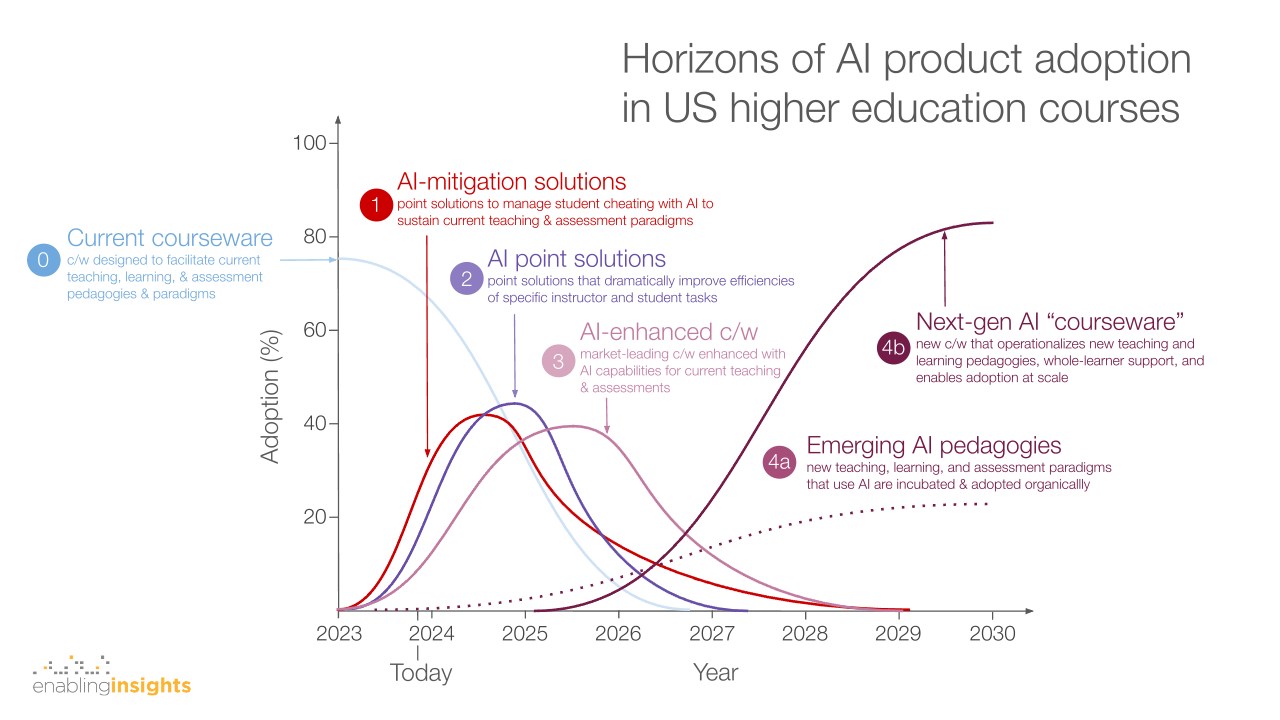Which AI edtech will win in higher education, when, and why?

Seeing through the fog of AI hype
Which AI edtech will win in higher education courses, when, and why? Making projections of tech trends is usually a fool’s errand—and especially with the speed of evolution of AI technologies. However, given the amount of hype, optimism, and anxiety that AI has provoked in the edtech industry, I’m going to put a stake in the ground and provide a personal view to guide edtech leaders of how I see the next 3-4 years playing out and why.
Who moved my pedagogy?
One of the most important lessons I’ve learned in nearly three decades of building successful courseware, assessing high-growth edtechs, and advising startups is that technologies aren’t adopted in higher education in a vacuum. The adoption of edtech (at the course level) is governed by how well established the teaching and learning pedagogies are that they support, and the flair and efficiencies that they bring to those tasks. New teaching, learning, and assessment strategies (and especially those that are evidence based) take time for innovative educators to incubate, refine and operationalize, and coach peers to adopt, and then for forward-looking educators at other institutions to adopt organically and at scale. It’s this educational context that creates markets for new edtech—and rate-limits their adoption. And, it’s today’s most established teaching, learning, and assessment paradigms that underpin the market for today’s market-leading courseware.
Projecting horizons of AI product innovation and adoption
Looking through this lens of educators and their practices in higher education, and assessing the speed of change of educational practice (see, for example, the thoughtful assessments by the Office of Educational Technology at the DOE and the OECD), I’ve built a schematic projecting horizons of AI production innovation and adoption. Unpacking this: today, we’re seeing a flurry of edtech solutions to mitigate students’ use of AI and preserve existing teaching paradigms. Alongside these, we’re seeing the emergence of a number of innovative AI point solutions that don’t challenge existing paradigms either—they just dramatically improve efficiencies of specific instructor or student tasks. And slightly behind that, a wave of “AI-enhanced” courseware—where the current market-leading courseware are augmented with AI tutors, a much wider range of gradable activity types, and richer formative insights into students’ performance and mindsets.
But the really exciting wave of innovation is one that’s fairly invisible right now—where innovative educators are experimenting with AI to enable new ways to teach, new ways to learn, and new skills for students to acquire (and be assessed on) for a fast-changing world. These will start to make the market-leading courseware increasingly irrelevant (regardless of how it’s been enhanced) and existing markets will fracture and fragment. And, it’s not until these new pedagogies have been polished and adopted at some scale by other educators that new markets will emerge, stabilize, and grow large enough for a new generation of courseware to emerge and further accelerate those paradigms.
Challenges for current market leaders and break-through opportunities for smart startups
Clayton Christensen articulated in his classic book, The Innovator’s Dilemma, that when you have a product that’s a market leader, it’s very hard to innovate because you risk disenfranchising your current customer base. In this case, I personally believe that the new pedagogies that will emerge that really exploit AI are likely to be sufficiently different from today’s that it won’t be possible for existing courseware to morph to fit. For example, a wave of new products has already been launched that allow instructors to build interactive activities and assessments automatically from seed instructional content (their lecture notes, a page from a research article or a textbook)—for example, Formative, Conker, and NolejAI. The quality of the assessments from these tools is now good enough that it dramatically undermines the core value proposition of existing market-leading courseware—“[MyProduct] provides you with better activities and assessments than you could (or have time to) create.” Equally, for startups that are unencumbered by existing pedagogies and a large customer base, this represents a break-through opportunity that comes about only every couple of decades—to innovate and accelerate the next generation of pedagogies to become the market leader of the future.
It’s time for new blood
Existing market-leading courseware products have enjoyed an incredible run (most were born more than 15 years ago). It’s time for new blood and AI will create that opportunity. My best advice to edtech startups eyeing this prize: start with the educational opportunity, innovative educators, and the real-world contexts of your future customers—not AI and your technology. It’s going to be a thrilling chapter in education and a rare opportunity for a shakeup in edtech market leadership—grab it.
Need help to refine your strategy?
If you want an objective assessment of your edtech strategy and practical recommendations for how to sharpen and accelerate it, please reach out—we’d love to help. We also welcome your feedback or questions on this blog—just use the form below and start “Your challenge” with the word “Feedback.”
